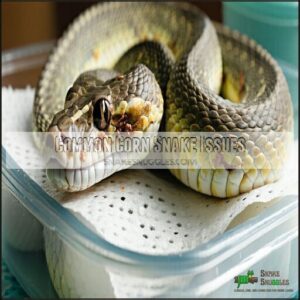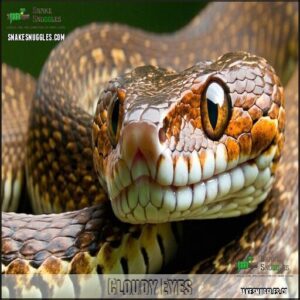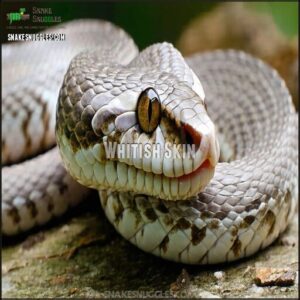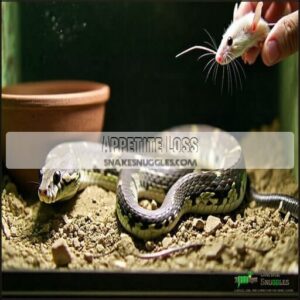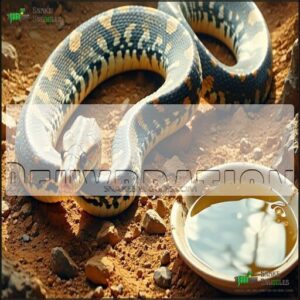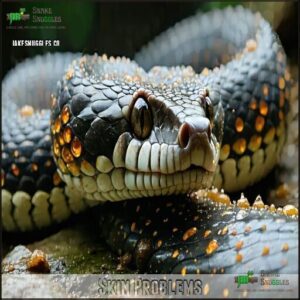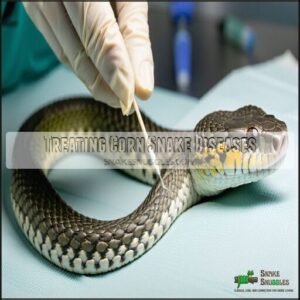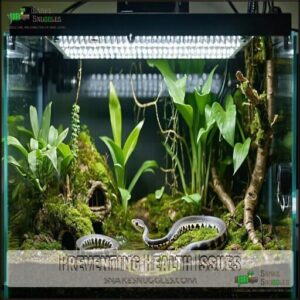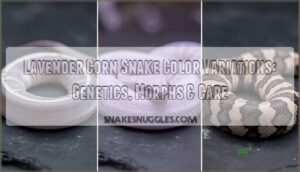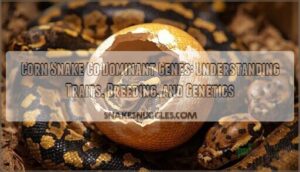This site is supported by our readers. We may earn a commission, at no cost to you, if you purchase through links.

Respiratory infections often crop up in poor humidity, causing wheezing or nasal bubbles. Stuck sheds (dysecdysis) can result from low moisture, leaving them wrapped in scraps of old skin.
Mouth rot (stomatitis) starts as swollen, infected gums and worsens if untreated. Metabolic bone disease is rarer but can be serious, causing soft, weak bones from calcium imbalance.
Watch for signs like lethargy, appetite loss, or odd skin changes. A clean habitat, proper diet, and close observation go a long way toward keeping your snake thriving.
Table Of Contents
Key Takeaways
- Keep humidity 40–60% to prevent shedding issues, dehydration, and respiratory infections.
- Watch for health warning signs like wheezing, appetite loss, or lethargy; early intervention can save your snake.
- Maintain enclosure hygiene with regular cleaning and safe substrates like aspen to avoid infections and skin problems.
- Feed appropriately sized prey and avoid overfeeding to prevent obesity and digestive issues.
Common Corn Snake Issues
Corn snakes are generally hardy, but they’re not immune to health problems.
Understanding common issues like respiratory infections, mouth rot, and shedding troubles helps you catch problems early and keep your snake healthy.
Respiratory Infections
Respiratory infections in corn snakes, often caused by low temperatures or poor humidity, can lead to breathing difficulties.
Respiratory infections strike when enclosures lack warmth or humidity—watch for wheezing and act fast to keep your snake thriving.
Watch for wheezing, nasal discharge, or lethargy—classic RI symptoms.
Prompt treatment includes veterinary care, proper hydration, and maintaining a warm, consistent enclosure.
Bacterial infections are a common cause.
Prevent snake respiratory issues by keeping humidity levels balanced and ensuring ideal enclosure conditions.
Prevention beats treating snake respiratory infections, focusing on proper hydration and a warm, consistent enclosure to avoid bacterial infections.
Stomatitis
Stomatitis, or mouth rot, is a common issue in corn snakes caused by bacterial infections.
Mouth rot in corn snakes, caused by bacterial infections, harms their health—early care and hygiene keep your snake thriving!
Watch for swelling, pus, or a foul odor. Left untreated, it can harm your snake’s jaw and lungs.
Here’s how to help:
- Improve hygiene in their enclosure.
- Seek veterinary care for antibiotics.
- Prevent stress with proper husbandry.
Healthy snakes thrive!
Dysecdysis
Dysecdysis, or shedding trouble, happens when humidity levels or substrate choice isn’t right.
Common issues include snake skin conditions like retained eyecaps.
Avoid handling issues by leaving your snake alone during shedding.
Track shedding frequency and signs, like cloudy eyes.
Proper care prevents corn snake shedding problems—think of it as helping them swap their “old clothes.”
Monitoring corn snake’s humidity needs is essential for healthy shedding.
| Problem | Cause | Prevention | Solution |
|---|---|---|---|
| Retained Eyecaps | Low Humidity | Maintain 40–60% humidity | Vet if severe |
| Incomplete Shed | Dry Conditions | Mist enclosure lightly | Provide shedding box |
| Skin Tears | Rough Objects | Smooth décor | Address wounds gently |
| Stuck Shed Residue | Stress or Handling | Avoid handling in shed | Warm damp towel rub |
Metabolic Bone Disorder
Metabolic Bone Disorder (MBD) is a serious reptile health issue caused by calcium deficiency, poor UVB lighting, or an unbalanced diet.
It weakens a snake’s bone structure, leading to deformities and mobility issues.
Watch for slack jaws or twitching muscles—classic MBD symptoms.
Prevent this by including dietary supplementation, proper UVB lighting, and calcium-rich diets in your corn snake health routine to avoid mobility issues.
Snake Health Signs
When your corn snake isn’t feeling its best, its body will show you clear signs of trouble.
Learning to spot cloudy eyes, shedding problems, or changes in appetite helps you catch health issues early.
Cloudy Eyes
Cloudy eyes in snakes are often part of the shedding process, but they can signal issues.
Watch for:
- Retained eye caps, also called spectacles.
- Snake eye discharge linked to infection signs.
- Injury causes like habitat sharp edges.
- Sudden clouding outside shedding cycles.
- Persistent problems needing snake veterinary consultation.
Check conditions early to protect their vision!
Whitish Skin
Whitish skin on corn snakes often signals the shedding process, which is completely natural.
However, if scales show discoloration outside shedding or seem patchy, it might point to snake skin issues like fungal infections, mite infestations, or even genetic anomalies.
Maintain humidity levels steady, as proper moisture prevents stubborn spectacles (eye caps) and helps avoid potential snake skin conditions, ensuring a healthy environment to prevent issues like mite infestations and promoting overall well-being through proper moisture.
Appetite Loss
Loss of appetite in corn snakes isn’t uncommon but can signal stress factors, an upcoming shedding cycle, or brumation signs in cooler months.
Enclosure temperature and humidity imbalances or parasitic infection may also play a role.
Monitor your snake’s eating habits closely, and if anorexia in reptiles persists, consult a reptile veterinarian to rule out serious corn snake health issues.
Lethargy can also be an indicator, so monitor for illness to address potential health issues.
Regurgitation
Regurgitation, while unsettling, happens when a corn snake spits out its meal shortly after eating.
Causes include stress, improper handling, or low enclosure temperatures disrupting the snake’s digestive process.
Prevention is key—avoid handling after meals and maintain ideal temperatures.
Frequent regurgitation requires immediate attention, as it signals severe health issues. Monitor feeding conditions to address this snake common issue effectively, which is crucial for the snake’s overall well-being.
Recognizing Sick Snakes
Knowing when your corn snake isn’t feeling its best can make all the difference in its health.
Watch for small changes in behavior or appearance, as these can be early warning signs of illness.
Lethargy
Feeling like your corn snake is unusually sluggish? Lethargy is often linked to snake illness signs like infections, poor temperatures, or improper diet.
Identifying lethargy might involve reduced activity and loss of appetite. Causes of lethargy range from stress to respiratory issues.
Preventing lethargy starts with maintaining proper care. If concerned, treating lethargy may require a vet trip to assess reptile health issues.
Dehydration
If your corn snake seems sluggish, has wrinkled skin, or rarely drinks, dehydration could be the culprit.
Low humidity levels are common causes and can lead to reptile health issues like stuck sheds.
Make certain humidity stays between 40-60%, boosting it during shedding.
Provide fresh water daily, and mist the enclosure to maintain proper hydration for snake health.
Obesity
Too much food and too little movement can lead to snake obesity, a growing corn snake health issue.
Watch for these overfeeding signs:
- Thick, sausage-shaped appearance with no visible spine or ribs.
- Difficulty moving or climbing—exercise importance matters!
- Fat deposits around the base of the snake.
- Decreased activity levels.
Prevent corn snake obesity with smart weight management: portion-control and a nutritious diet suited to their needs, which is essential for maintaining a healthy and active lifestyle.
Skin Problems
A snake’s skin tells a story.
Issues like blisters, abscesses, or scale rot need quick attention.
Watch for mites or flaky skin that won’t shed.
Keep the habitat clean and humidity balanced to prevent infections and scarring.
A key factor in prevention is maintaining proper humidity to facilitate healthy shedding.
Below is a quick guide to common corn snake skin problems:
| Problem | Signs | Prevention |
|---|---|---|
| Blisters | Red, fluid-filled bumps | Humidity control |
| Abscesses | Swollen, pus-filled lumps | Clean enclosure |
| Scale Rot | Discolored, soft scales | Dry, clean bedding |
| Mite Infestation | Tiny, moving dots | Inspect regularly |
| Retained Shedding | Old skin patches remain | Boost humidity |
Treating Corn Snake Diseases
Treating your corn snake’s illnesses quickly and correctly can make all the difference in their recovery.
From medications to environmental changes, it’s essential to address the root causes with care.
Veterinary Care
Seeing a snake specialist vet is key to keeping your corn snake healthy.
Exotic veterinarians handle preventative care and emergencies.
Here’s what to do:
- Schedule annual checkups for early problem detection.
- Seek diagnostic testing if your snake shows unusual symptoms.
- Keep a reptile vet’s contact handy for emergencies.
Snake exotic pet care saves lives!
Medication
When treating snake disease, medication often plays the hero.
Dosage calculation must be precise—too much or little can worsen things.
For respiratory infections, antibiotics like Enrofloxacin work wonders.
Antifungal options tackle stubborn skin issues.
Pain management might involve dexamethasone.
Administer snake medication orally or via injection as prescribed.
Always watch for antibiotic resistance, and consult your vet for snake parasite treatments.
For skin issues like scale rot, Betadine solution soaks can be beneficial, helping with scale rot.
Dietary Changes
If a corn snake stops eating, tweak its diet.
Check prey size—it shouldn’t exceed the snake’s midsection width.
Adjust Feeding Frequency to prevent Obesity.
Try switching prey types or colors to stimulate appetite.
Whole prey offers balanced nutrition, so avoid plain meat.
Supplements like calcium or vitamin D3 might help if the snake’s health shows signs like Food Refusal or regurgitation.
Many owners look for specialized snake food to guarantee proper nutrition.
Environmental Adjustments
Your corn snake’s comfort starts with proper habitat setup.
Maintain a thermal gradient of 85°F on the warm side and 70-75°F on the cool.
Keep humidity levels around 40-60%, boosting to 70% for shedding.
Use safe substrate choices like aspen or reptile carpet.
UV lighting and the right enclosure size guarantee a stress-free, healthy environment—your snake will thank you!
Preventing Health Issues
Keeping your corn snake healthy starts with simple steps like providing clean water, a balanced diet, and a spotless enclosure.
Regular checkups guarantee you catch potential issues early, saving you stress and your snake a trip to the vet, which is a key part of maintaining their health, particularly through regular checkups and a balanced diet.
Proper Hydration
Water availability plays a big role in preventing snake health issues.
Always keep fresh water in a sturdy dish.
Proper humidity levels (40-60%) support skin health and shedding aid.
Watch for dehydration signs like sunken eyes or wrinkled skin.
Hydration methods include misting the enclosure gently.
Great corn snake care means prioritizing reptile hydration to avoid problems down the road, ensuring proper humidity levels are maintained.
Balanced Diet
A balanced diet is key to your corn snake’s health.
Stick to thawed frozen rodents, sized to match the widest part of its body for proper digestion.
Feed adults every 7-10 days and juveniles more often.
Avoid overfeeding to prevent obesity.
Supplementation isn’t usually needed but guarantee hydration importance by keeping fresh water nearby after feeding sessions.
Clean Enclosure
A clean enclosure isn’t just tidy—it’s essential for reptile health care.
Regular snake tank maintenance involves daily waste removal, cleaning water dishes for water hygiene, and weekly disinfecting methods to keep germs at bay.
Use safe substrates like aspen, and don’t skip enrichment sanitation.
Effective cleaning requires a suitable reptile disinfectant.
Spot-clean often—it’s like giving your snake a fresh start every day!
Regular Checkups
A quick vet visit each year can work wonders for snake health monitoring.
Regular checkups mean early detection of health issues you might miss, like respiratory infections or parasites.
Preventative care helps avoid costly veterinary care later.
Watch for signs of health changes, and don’t skip exams; even corn snakes benefit from a little professional attention to stay in tip-top shape and receive regular checkups.
Frequently Asked Questions (FAQs)
How to identify genetic issues in corn snakes?
Spot genetic problems by observing abnormal physical traits, like kinked spines or oddly patterned scales.
Watch for health issues, including weak immune systems.
Some morphs, like scaleless snakes, might struggle with shedding or developing infections.
What causes cloacal prolapse in corn snakes?
Cloacal prolapse in corn snakes happens when internal tissue extends out of the vent.
It’s often caused by constipation, dehydration, overexertion during laying eggs, parasites, or digestive issues.
A vet visit is essential for treatment.
Are UV lights necessary for corn snake health?
UV lights aren’t a must for corn snakes, but they’re helpful.
A low-strength UVB bulb can mimic natural sunlight, boosting health and well-being.
It’s like adding a little sunshine to their world!
How does substrate type affect health risks?
The wrong substrate can cause skin irritation, respiratory issues, or stuck shed.
Pine or cedar shavings are a no-go due to harmful oils.
Stick with aspen or reptile carpet for a healthier, happier snake.
What signs indicate parasitic infections in corn snakes?
Watch for signs like sudden weight loss, lethargy, unusual behavior, or odd changes in stool consistency.
You might find mites on their skin or evidence of worms.
If you’re unsure, visit a reptile vet.
Conclusion
Did you know that about 80% of reptile health issues stem from improper care?
Keeping your corn snake healthy means paying close attention to its environment and behaviors.
By addressing common health issues like respiratory infections or mouth rot early, you can prevent more serious problems.
A clean setup, proper humidity, and a balanced diet are your best defenses.
Stay observant, and your corn snake will thrive—because a happy, healthy snake makes for a happier snake owner!

